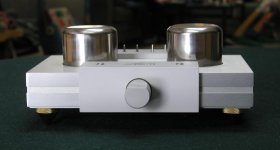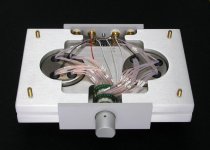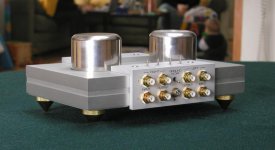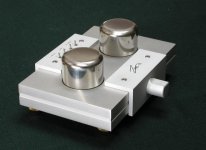Just as I was getting used to your previous TVC assembly....you take it a step further...I'm currently putting one of those together, here's how the mounting is done
Why do I get the feeling that this last version is going to look "ABSOLUTELY STUNNING!!"
Konnichiwa,
I am not sure what this is like now. Therefor again:
WHAT VALUE OUTPUT COUPLING CAPACITOR DO YOU USE?
Larsen effect? You mean acoustic feedback?
Well, whatever it is, if you wired everything correctly it should not happen. Therefore, can you check what you have ACTUALLY wired up, sounds to me like something is not wired right?
Sayonara
patriz said:I'm using Fedde dac schematic.
I am not sure what this is like now. Therefor again:
WHAT VALUE OUTPUT COUPLING CAPACITOR DO YOU USE?
patriz said:By the way I discover some interaction betwen the phono cable and the tx102 in particular the phono ground. Moving
the phono cable, even if the source selected is cd, is some position I have Larsen effect, and if I completly remove phono connectors and mains the sound clearly is better.
Larsen effect? You mean acoustic feedback?
Well, whatever it is, if you wired everything correctly it should not happen. Therefore, can you check what you have ACTUALLY wired up, sounds to me like something is not wired right?
Sayonara
Just as I was getting used to your previous TVC assembly
Yes. The old one really sucks now 🙂 Good thing i never tried copying it...
Hello,
another question:
it is said that the input signal coming to the TX102 must be free of DC; what happens if not? Saturation? Fire? (Of course, not) ... what about 1mV? I want to avoid any coupling cap ...
Cheers
Christian.
another question:
it is said that the input signal coming to the TX102 must be free of DC; what happens if not? Saturation? Fire? (Of course, not) ... what about 1mV? I want to avoid any coupling cap ...
Cheers
Christian.
Konnichiwa,
Depending upon how much DC, you may saturate the core and even permanently magnitise the core material (which is not really recoverable without heat tratment of the material).
Depends. If sourced from a zero source impedance it will cause around 3uA DC current to flow. This should be completely harmless. if on the other hand 3mA where flowing (eg 1V offset) I would suggest a real problem is present and must be addressed before connecting the TVC.
Sayonara
krishu said:another question: it is said that the input signal coming to
the TX102 must be free of DC; what happens if not?
Depending upon how much DC, you may saturate the core and even permanently magnitise the core material (which is not really recoverable without heat tratment of the material).
krishu said:what about 1mV?
Depends. If sourced from a zero source impedance it will cause around 3uA DC current to flow. This should be completely harmless. if on the other hand 3mA where flowing (eg 1V offset) I would suggest a real problem is present and must be addressed before connecting the TVC.
Sayonara
Is 4,7x2 Black gate non polar each channel.Kuei Yang Wang said:Konnichiwa,
I am not sure what this is like now. Therefor again:
WHAT VALUE OUTPUT COUPLING CAPACITOR DO YOU USE?
Larsen effect? You mean acoustic feedback?
Well, whatever it is, if you wired everything correctly it should not happen. Therefore, can you check what you have ACTUALLY wired up, sounds to me like something is not wired right?
Sayonara
I got pretty strong rumours in the speaker (horn) as I go close or touch the trans.
I will ceck connection again.
gio
Peter,
Very cool looking work. Do you have your aluminum CNC machined? Pretty neat.
Also, are those silver TXs you're using? I notice the wires are colored differently.
You mentioned that the aluminum may sound different than the acrylic. I've found, in my experience, that vibrational effects often influence the sound, sometimes drastically (but sometimes not so drastically).
How does the aluminum sound compared to the acrylic? Have you tried bronze, brass, or copper for this application?
I guess that leads me to this final question: How greatly are the TXs affected by vibration?
Great work. Very enviable.
Best,
KT
Very cool looking work. Do you have your aluminum CNC machined? Pretty neat.
Also, are those silver TXs you're using? I notice the wires are colored differently.
You mentioned that the aluminum may sound different than the acrylic. I've found, in my experience, that vibrational effects often influence the sound, sometimes drastically (but sometimes not so drastically).
How does the aluminum sound compared to the acrylic? Have you tried bronze, brass, or copper for this application?
I guess that leads me to this final question: How greatly are the TXs affected by vibration?
Great work. Very enviable.
Best,
KT
Regarding inputs being free of DC, I am only using commercial inputs (marantz CD-17, Arcam DV88 etc) can I be sure they are free of DC?
If not how should I check them?
Regards
TC
If not how should I check them?
Regards
TC
How greatly are the TXs affected by vibration
More than i expected. My first trial was with a steel chasis and mounting brackets - not nice at all. The removal of the tight brackets seemed to help somewhat and moving them to a wooden box was really better.
Sayonara,
That should be okay.
Definitly something wired wrong.
Do you use an on-line translator for your posts? The english seems unusal and often not particulary clear, making it difficult to understand your problems clearly.
Sayonara
patriz said:Is 4,7x2 Black gate non polar each channel.
That should be okay.
patriz said:I got pretty strong rumours in the speaker (horn) as I go close or touch the trans. I will ceck connection again.
Definitly something wired wrong.
Do you use an on-line translator for your posts? The english seems unusal and often not particulary clear, making it difficult to understand your problems clearly.
Sayonara
Konnichiwa,
Yes, they are all engineered to do that. One should note that if these commercial sources are modified a common mod is to bridge out the output coupling capacitors (which usually only block insubstantial DC levels). Such modified units should be checked using a millivolt DC reading Multimeter.
A reading of a few millivolt or even a little more (as is often found in commercial gear) is uncritical in our experience, however there is no OFFICIALLY stated or warranted tolerance to DC offset, therefore the responsibility to keep this to a minimum lies with the user.
In practice over 4 Years and many shipped transformers have not had one return with permanently magnetised cores (full stop) and certainly not from commercial well-designed gear.
Sayonara
wytco0 said:Regarding inputs being free of DC, I am only using commercial inputs (marantz CD-17, Arcam DV88 etc) can I be sure they are free of DC?
Yes, they are all engineered to do that. One should note that if these commercial sources are modified a common mod is to bridge out the output coupling capacitors (which usually only block insubstantial DC levels). Such modified units should be checked using a millivolt DC reading Multimeter.
A reading of a few millivolt or even a little more (as is often found in commercial gear) is uncritical in our experience, however there is no OFFICIALLY stated or warranted tolerance to DC offset, therefore the responsibility to keep this to a minimum lies with the user.
In practice over 4 Years and many shipped transformers have not had one return with permanently magnetised cores (full stop) and certainly not from commercial well-designed gear.
Sayonara
Hello,
thanks for explaining what DC will affect ...
I hope an opamp (e.g. OPA627) as buffer AFTER a coupling cap will deliver sufficiently low DC offset. Should be well within millivolts...
Cheers
Christian.
thanks for explaining what DC will affect ...
I hope an opamp (e.g. OPA627) as buffer AFTER a coupling cap will deliver sufficiently low DC offset. Should be well within millivolts...
Cheers
Christian.
analog_sa said:
Yes. The old one really sucks now 🙂
Indeed, when looking at those old pictures, and the new version, the conclusion is obvious 😉
http://www.6moons.com/audioreviews/audiozone/amp2.html
Bas Horneman said:
Just as I was getting used to your previous TVC assembly....you take it a step further...
Why do I get the feeling that this last version is going to look "ABSOLUTELY STUNNING!!"
Well, this design went the whole circle and the latest version is much more sophisticated when it comes to finish and materials. I have a feeling that this will stay like that as it's kinda hard to change much more (except maybe for gold spikes).
Attachments
We use 1 3/8" aluminum platform, CNC machined, brushed and anodized. Material here definitely has importance on the sound, and my first impresion, comparing to acrylic, was that aluminum chassis was sort of midbass "heavy", but I have to do more comparisons to come to any conclusion.
I wouldn't dare to try copper, brass or bronze, if not only for high price of those materials, much harder machining and finishing. I also noticed that too much of those materials make for sort of too damped sound, less air, and for that reason we stopped using copper bar in the monoblocks and switched to aluminum.
The transformers are sourced from Bent Audio, and it comes with custom made OCC copper magnet wire and continous cast pure copper lead out wires.
Elma switch was always working well here, and the open deck design simplifies attaching the wires.
I wouldn't dare to try copper, brass or bronze, if not only for high price of those materials, much harder machining and finishing. I also noticed that too much of those materials make for sort of too damped sound, less air, and for that reason we stopped using copper bar in the monoblocks and switched to aluminum.
The transformers are sourced from Bent Audio, and it comes with custom made OCC copper magnet wire and continous cast pure copper lead out wires.
Elma switch was always working well here, and the open deck design simplifies attaching the wires.
Attachments
The front and rear angles are sand blasted, with matte finish, and this provides for interesting combination with brushed main platform. Simple Allen type screws attach both brackets. This time silkscreening is also implemented. There is an additional switch in a back to "float" the ground.
Attachments
This product was basically developed here, on a forum. I posted first pictures as I was practicaly working on a prototype, later it went through some different revisions and cosmetic changes, and now it's fully finalized, with finish and looks matching the big players in a marketplace. Yet, it's still different than almost anything else out there 😉
Attachments
Hello Peter,
looks really nice now; the lesser colors make it easier to look at it for a longer period of time ... I would wish to see some feet (spikes) matching the quality and look of the preamp and the gorgeous knob.
These gold spikes look like $1.00 speaker spikes from my electronics supplier next door ...
Cheers
Christian.
looks really nice now; the lesser colors make it easier to look at it for a longer period of time ... I would wish to see some feet (spikes) matching the quality and look of the preamp and the gorgeous knob.
These gold spikes look like $1.00 speaker spikes from my electronics supplier next door ...
Cheers
Christian.
looks really nice now; the lesser colors make it easier to look at it for a longer period of time ... I would wish to see some feet (spikes) matching the quality and look of the preamp and the gorgeous knob.
Absolutely...I thought the same thing...with the fewer contrasts...it looks really classy...the only thing letting it down are the spikes IMO.
I noticed that gold spikes are a big no no with Europeans. Here, in Americas, nobody's really complaining 😉
Those are quite nice, definitely not $1 variety, and they match RCA jacks. I was already thinking about powder coating them in some nice color (as making the new ones would be too expensive, considering the original cost of those).
Those are quite nice, definitely not $1 variety, and they match RCA jacks. I was already thinking about powder coating them in some nice color (as making the new ones would be too expensive, considering the original cost of those).
- Home
- Design & Build
- Parts
- how to build a pre using S&B TX-102 transformers



